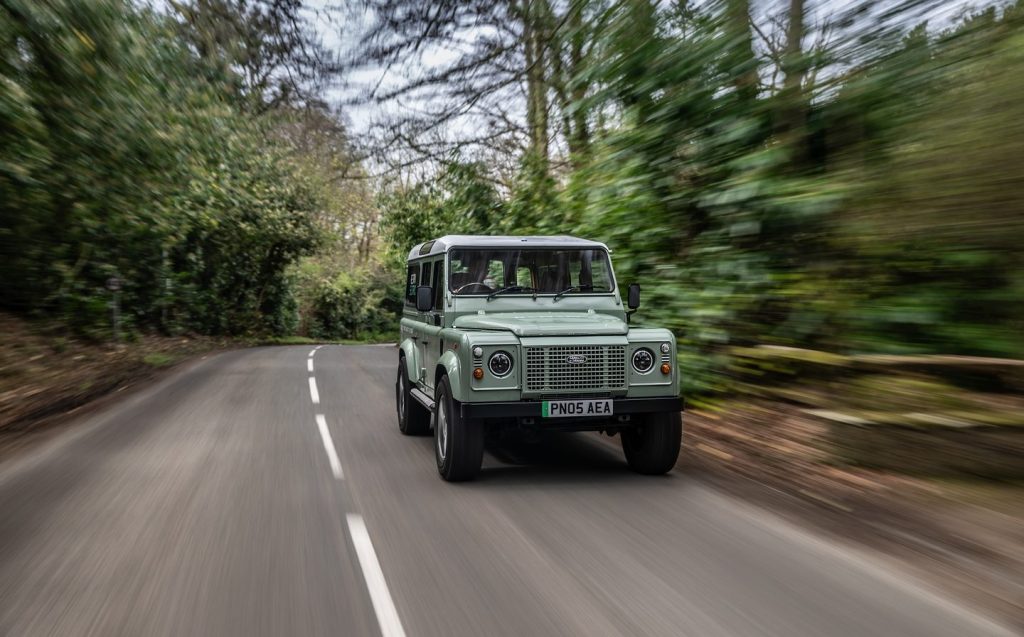British firm Bedeo launches new EV conversion kit for classic Defender
No problem mixing water and electricity here
Surrey-based engineering company Bedeo has revealed a new electric conversion kit for classic Land Rover Defenders that uses in-wheel motors.
It’s the first in a line of “Reborn Electric: Icons” vehicles with which the company is planning to use its in-wheel motor technology to electrify various classic vehicles.
Bedeo has already put its electric vehicle expertise to use in other vehicles, including working with Ocado and the Stellantis group, creating battery-powered refrigerated delivery trucks.

But now, after buying up in-wheel motor (IWM) firm Protean Electric, the company is using that technology in a Defender. Rather than housing the motor in the chassis or in the engine bay, Bedeo’s system puts the motors in the wheel hubs, allowing pretty much any vehicle to be converted to electric propulsion.
More than 150 miles on a charge
Using a 75kWh battery to provide power, the Defender used to kick off the Icons initiative can cover an estimated 153 miles on the official WLTP economy test, while charging takes five hours from a 22kW AC-charging point. Using a 50kW public charging point, Bedeo says the car will charge in 90 minutes.

In comparison, Electrogenic’s Land Rover EV conversion kit offers a range of around 100 miles, while Twisted’s electric Land Rover Defender 110 manages 180 miles on a single charge. However, neither of those uses IWM tech.
Although the Bedeo kit may not be ideal for long distances, it should be more than adequate for use on an estate, a farm or in public places such as parks and gardens.
Electric motors have the advantage of immediate torque (twisting force), unlike internal combustion engines, which only generate maximum torque within a certain rev range. That makes EVs ideal for low speed off-roading.
One disadvantage of in-wheel motors is said by engineers to be additional unsprung mass, though with electric motors becoming smaller and lighter this is a problem that may be overcome. It remains to be seen how it affects the dynamic ability of the Bedeo Defender on and off road.
No heavier than standard car
Bedeo adds that the car has maintained many of its original characteristics despite the loss of its original engine. Because the IWM tech is so light, the car weighs around the same as it did originally, even with the battery and on-board charging system included, and the company says it drives similarly to the combustion-powered version.

However, the company says the motor system runs almost silently, reducing the noise level inside the vehicle for drivers and passengers.
Although Bedeo has started the Icons line-up with the Defender, the company hopes it can engage with customers to convert other vehicles to electric power.
“The classic car community has warmly embraced the idea of converting their beloved vehicles to run on electric power through EV conversion,” claimed Osman Boyner, the founder of Bedeo.
“However, until now, none have ventured into utilising in-wheel motors to tap into the advantages of weight reduction and engineering enhancements.

“Through our Reborn Electric: Icons programme, we are committed to maintaining the original car’s kerb weight, charm, and driving dynamics while ensuring easy maintenance and delivering the benefits of electrification.
“For the Defender, and other models to come, this means zero tailpipe emissions, zero noise, and the preservation of the nostalgic, classic driving experience we all cherish, now brought into the 21st Century without sacrificing its essence or adding unnecessary, bulky weight.”
More than just the electric motors
Although the company is marketing the systems as off-the-shelf kits, Bedeo says it wants customers to tailor overhauled cars to their specifications, allowing for flexibility depending on the customer’s needs.

It says it is also collaborating with partner firms to allow customers to customise their vehicle in other ways, allowing for “every aspect” of the car to be tailored.
“We’re not simply converting cars to electric power,” said Boyner. “We’re preserving automotive heritage, while enabling the clean and efficient transportation of the future, with a technology that has only been preserved for large OEMs (original equipment manufacturers, or carmakers and their suppliers) and brand-new vehicles, until today.”
First founded in Turkey in 2009, Bedeo started out building electric vehicles for a Turkish shipping company, and then moved into the UK market.
After forming partnerships with TNT, DHL and FedEx, the company sold electrified Fiat vans to Ocado, before establishing a more formal arrangement with the Stellantis group to create electric commercial vehicles. The firm currently claims to offer electric powertrains for any vehicle “on land, sea or air.”
Related articles
- If you liked reading about the Bedeo electric Land Rover Defender conversion, you might also like to check out our Healey by Caton review, and why this half-million-pound restomod is a little too authentic in its classic car experience
- Alfa GT restomod packs 493bhp twin-turbo V6 from Giulia Quadrifoglio
- Milivié 1 is a modernised VW Beetle restomod with a €570,000 price tag
Latest articles
- Should I buy a diesel car in 2025?
- F1 2025 calendar and race reports: The new Formula One season as it happens
- Zeekr 7X AWD 2025 review: A fast, spacious and high tech premium SUV — but someone call the chassis chief
- Denza Z9GT 2025 review: Flawed but sleek 1,062bhp shooting brake from BYD’s luxury arm
- Extended test: 2024 Renault Scenic E-Tech review
- Best-selling cars 2025: The UK’s ten most popular models of the year so far
- Audi A6 Avant 2025 review: Trusty executive estate ticks expected boxes, and there’s still a diesel option
- Keir Starmer eases pressure on carmakers to sell EVs in response to ‘global economic headwinds’
- Ferrari 12Cilindri Spider review: Heady blend of traditional and futuristic becomes even more intoxicating after lid is removed














